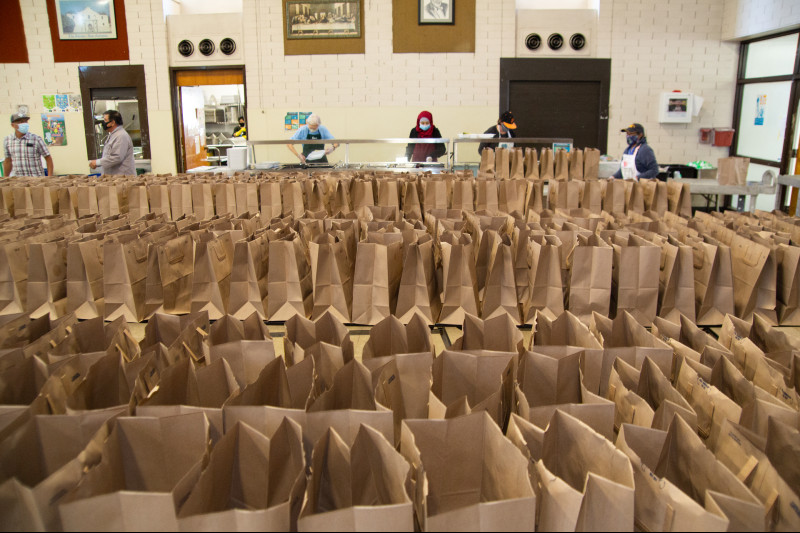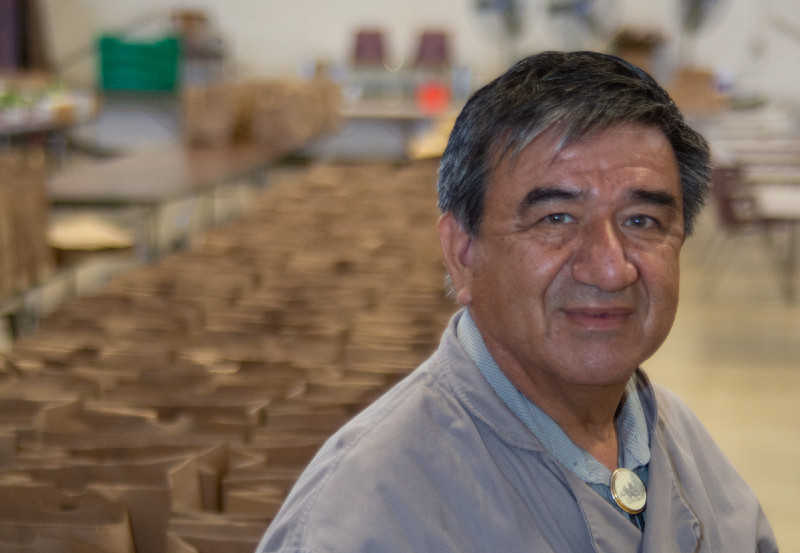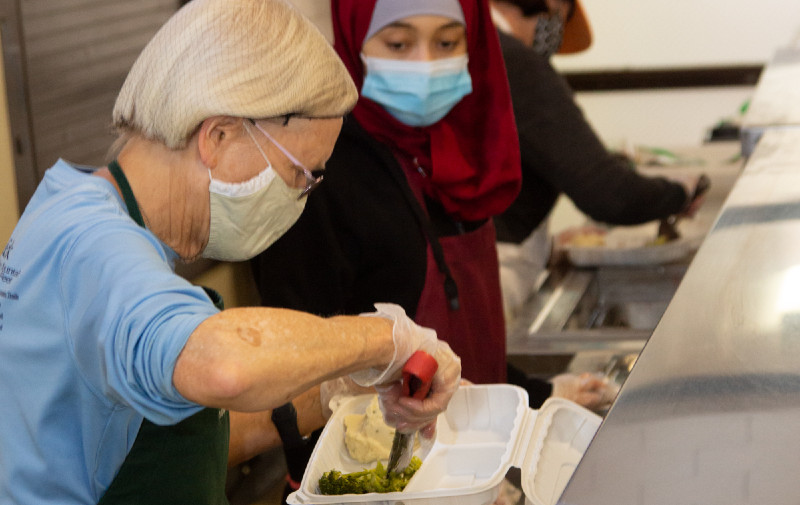By Nancy Mangini
“We Feed the Poor:” It’s a mission statement, a commitment, and a way of life for everyone associated with Saint Anthony’s Padua Dining Room in Menlo Park. Located on Middlefield Road behind Garfield School, just across the Redwood City limit line; the dining room serves hot, nutritious meals free of charge to all who come to the door.
“We have been in continuous operation for 47 years, six days a week, 52 weeks a year,” said Operations Manager Max Torres. “We never ask who you are, what brings you to our dining room, or why you may need food. You are our guest and we offer you a meal with no questions asked.”
Begun in 1974, the Padua Dining Room in Menlo Park is a program of Saint Anthony’s Parish in San Francisco and is supported by tax-exempt donations just like its more well-known sister to the north. Their finances are entirely separate, so contributions to the Padua Dining Room go the Menlo Park organization, according to Torres.
In addition to donations of money and supplies, the dining room depends largely on volunteers who faithfully perform jobs such as delivering supplies, chopping vegetables, preparing meals and greeting guests. Pre-Covid, at least 40 volunteers per day were involved in preparing and serving the sit-down, indoor lunches. Over a year ago the pandemic forced a shift to packaged, hot takeaway meals, which, for safety reasons, meant using more paid staff and fewer volunteers.
At the same time, the demand tripled.
“The number of guests we serve went from 100 to more than 300 per day,” Torres said. “When the pandemic ends and the county health officials give us new protocols for keeping everyone safe, we hope to reopen our indoor dining program and will welcome back more of our family of volunteers.”

Torres says a shared belief that all human souls deserve good food and a welcoming place to receive it motivates the dedicated volunteers who are essential to the program.
The Tuesday Team
One of them is Gini Dold, a retired San Francisco teacher and education administrator, who volunteers every Tuesday morning.
“I was aware of the St. Anthony’s program in San Francisco, then heard about this one near Redwood City, so I came to check it out and fell in love with what they do. We are the Tuesday Team,” she said proudly, referring to the half-dozen volunteers working in the kitchen before the 11 a.m. to 1 p.m. takeout meal distribution program starts. “It’s a great group of people. The work we do here is important and the need is growing during the pandemic.”
Chuck Martin, a retired structural engineer who also volunteers with Meals on Wheels and Habitat for Humanity, came to help out at the dining room five years ago. “It’s fun,” the Menlo Park resident said, while rinsing handfuls of chopped peppers. “I like the people a lot. We’re like a small family in the kitchen.”
Kate Parnes, a retired Santa Clara County special education teacher who lives in Emerald Hills, had been volunteering at Second Harvest Food Bank helping people sign up for food stamps. The Tuesday morning service she does at St. Anthony’s “offered more hands-on work,” she said. “So I came here. And you know, when you do this kind of volunteer work, you get back so much more than you give. I just love it.”
Henry Wilder is a retired venture capitalist from Woodside who volunteers in the kitchen on Wednesday mornings. “Not only is it a good cause,” he said. “It’s pure charity.”
Torres has a simple answer for how St. Anthony’s has been able to keep up with a significantly higher demand, serving meals every day except Sundays, without skipping a beat: “Because of our mission. We feed the poor.”
Who Are “The Poor?”
In San Mateo County, the definition of “poor” can range from the income needed to be eligible for federal food assistance programs to the amount it takes to be financially self-sufficient. Between these two standards, more than 250,000 individuals in the county are considered to be food insecure, meaning they have limited or uncertain access to nutritionally adequate and safe foods. They don’t qualify for federal food assistance programs because their income is higher than the federal poverty level but less than the amount it takes to cover basic needs in this very expensive area.
To be eligible for food assistance from state and federal programs such as CalFresh, SNAP, and SCRIPT (food stamps), a family of four consisting of two adults and two children must be able to prove a net annual income of less than $26,500 per year, according to the U.S. Department of Health and Human Services’ 2021 Federal Poverty Guidelines.
At the other end of the scale, the net annual income needed in Silicon Valley by that same family to pay for the basic needs of housing, utilities, groceries, healthcare, childcare, transportation, and other necessities, without additional help, is currently estimated to be $110,000 – $160,000 per year, according to the Insight Center, an arm of the Population Resource Bureau in Washington D.C.
Growing Numbers
Before the pandemic, Get Healthy San Mateo, a program of the county health department, had projected that roughly 11 percent of the population, or 81,000 people, would become food insecure in 2020. By July of that year, according to the agency’s website, that figure had risen to 30 percent, or nearly one in three residents, and was still going up.
In its comprehensive report, “The Cost of Being Californian 2021,” the Insight Center attributes the catastrophic rise in this area’s food insecurity to widespread unemployment caused by the pandemic shutdown, coupled with a steady increase in the cost for basic needs.
Faced with such overwhelming need by residents, San Mateo County, along with other Bay Area counties, responded by expanding existing food programs and supporting new ones initiated by the nonprofit community. With money from the San Mateo County Strong Fund, food and supply donations from businesses and philanthropic organizations, and an army of new volunteers, county residents who need food and other assistance can turn to a growing number of organizations for help.
Though there are many programs offering food and general assistance, the application process can sometimes present a significant barrier to getting it.
To qualify for any of the alphabet soup of government-funded food assistance programs, applicants must produce documentation that includes a state-issued ID such as a driver’s license, proof of income from pay stubs or bank statements, proof of residency from utility bills or rental receipts, and proof of immigration status. As might be expected, when many of those whose income level qualifies them for government help are Hispanic, homeless, or undocumented; producing the required “proof” is often not an option.
Hurdles to Qualifying
In addition to government-funded programs, nonprofits may also have qualification requirements such as residency in a certain area of the county or a minimum age for elder-support benefits. People may have to make appointments online or by phone or be able to exchange volunteer hours in exchange for food. Finally, the hours and days when assistance is consistently available varies widely throughout the county, ranging from one or two days a week for a few hours to one or two hours a day for a few days, with weekend programs being few and far between.

At St. Anthony’s Padua Dining Room, however, residents can reliably receive a meal—and more—no questions asked. In addition to a packaged hot, nutritious meal consisting of an entrée (such as meatloaf or chicken), vegetables, salad, fruit, bread, dessert, and a beverage; St. Anthony’s also offers guests free grocery bags filled with locally sourced fresh fruit and vegetables and many kinds of bread.
On a recent day, grateful guests were lined up patiently waiting for the doors to open. Among them was an elderly man named Illis, who was enjoying his meal at one of the outdoor tables set up near the entrance. “I come every day,” he said. “I like the food.”
Yelena, a self-described retired corporate executive who came for lunch, believes the program does a lot of good but she thinks corporations should be doing more. “We should be getting the word out to the media like KCBS so that people will see what is needed and maybe try to help,” she said.
Really Meaning “No Questions”
Torres, who has been St. Anthony’s operations manager since 1990, tells the story of a man who used to come to the dining room regularly driving an expensive car, wearing elegant clothing, and “very good shoes.” In spite of the prohibition against asking guests any questions before offering them a meal, one day a volunteer could no longer contain his curiosity and asked the man why he came for meals when he had such an expensive car and nice clothes. The man looked down and answered quietly, “because that is all I have.”
Ashamed at causing the man’s obvious embarrassment, the volunteer never again asked guests why they came and simply offered them hot meals and a welcome place to enjoy them. “You never know what troubles other people face,” Torres explained. “We all have our burdens to bear, so the best we can do is try to help others bear theirs.”
Asked if all the new food assistance programs in the area might someday eliminate the need for the Padua Dining Room, Torres shook his head, repeating his mission statement and quoting from the New Testament. “We feed the poor, and the poor will always be with us.” For more information about St. Anthony’s Dining Room, including how to donate, visit www.paduadiningroom.com.






